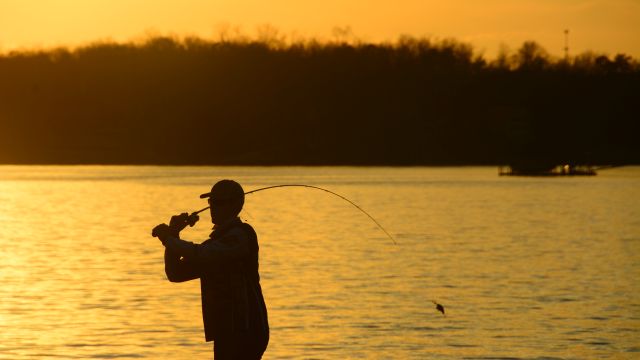Alabama Power, conservation officials give nature a little assist when gamefish spawn

Any good fisherman knows that small fish grow up to be big fish. Part of the rationale behind catch-and-release practices is to “throw them back and let them grow.” But before a little fish can grow into a bigger fish, an egg must turn into fry and fry must turn into fingerlings.
The spawn is an essential part of maintaining a healthy fish population, and a successful spawn can make the difference later in whether fish are plentiful or scarce. A multitude of variables influencing the aquatic environment can affect when fish lay their eggs and how successfully those eggs grow into fish.
Alabama Power tries to give nature a little bit of an assist during the critical time when fish are spawning.
“We have, for several years, held Smith on the Warrior and Weiss and Logan Martin on the Coosa for about two weeks,” says Angie Anderegg, hydro licensing and compliance supervisor for Alabama Power. “If we can from an operational standpoint, we will hold those lakes steady or slightly rising to facilitate the fish spawning.”
State biologists keep tabs on the lake water temperatures and other conditions that trigger spawning in gamefish. When the conditions are right, they contact company officials, who restrict or increase flows to keep the lake levels stable.
At Weiss and Logan Martin lakes, the emphasis is on when crappie and black bass species, which include largemouth bass and spotted bass, are spawning. At Smith Lake, the emphasis is on the black bass. Alabama Power also works with conservation officials at Lake Harris on the Tallapoosa River, said Mike Holley, district fisheries supervisor for the Alabama Department of Conservation and Natural Resources Division of Wildlife and Freshwater Fisheries.
“We’re trying to hold that water stable so that doesn’t affect nest success,” Holley said.
Weiss Lake is home to the only population of the Gulf strain of striped bass that are successfully reproducing outside of captivity. The fish run up into Weiss Lake’s headwaters in Georgia to spawn. To hatch, the eggs must tumble down the river for 72 hours without sinking to the bottom, and the long stretch of flowing water gives them that opportunity.
When water temperatures rise into the upper 50s in the spring, bass and crappie move into shallow water. Crappie look for a hard surface, such as a gravel bottom or rip-rap wall in 3 to 10 feet of water, Holley said. Spotted bass seek out similar habitat, while largemouth bass make their nests in shallower backwaters. Once they stake out spawning sites, it is important that water conditions remain stable or the fish will abandon their nests.
Biologists closely monitor water temperatures, watch other habitat signs and talk to fishermen who know the signs that are present when fish spawn. State officials usually make a request to Alabama Power to hold the water levels steady around early to mid-April.
“They’ve been very easy to work with in giving them the prime time and them following through,” Holley said of the company officials.
Anderegg notes that lake flood control is paramount.
“If we have to operate for flood control, that trumps everything,” Anderegg said. “If we get in a flood situation, we have to operate according to our flood control guidelines.”
Holley said biologists understand that flood control comes first. Otherwise, stabilizing the water levels has been a boost to fish populations.
“As long as nature allows it, it has been a good process,” Holley said.
Comparing what humans can do in a hatchery against what nature does illustrates why the spawn is so important. The Conservation Department releases crappie into Weiss Lake every year. The state hatchery can produce about 500,000 hatchlings in a season, Holley said. That production can be equaled by about 15 pairs of crappie in the wild. A mature female crappie can produce 30,000 to 350,000 eggs a year.
“Our hatcheries can’t even get close to what can be produced naturally,” Holley said. Research has found that fingerlings released by the state make up only about 2 percent of the total catch in Weiss Lake.
Professional crappie guide Mark Collins said there is a pattern that results in successful spawns.
“Over the years, they’ve noticed a trend that when we have wet winters and high spring water levels and hot summers, we have a good spawn,” said Collins, a guide on Weiss Lake.
Heavy rains sometimes make good spawning habitat for fish, Holley said. Then, the dry, hot summer weather promotes the growth of the zooplankton that crappie fry feed on.
Catching spawning crappie and bass can be difficult. Both species shut down their feeding activity when spawning begins. But some of the best fishing occurs immediately before bass and crappie spawn.
“The peak time for fishing covers about a week before the spawn,” Holley said.
Both species of fish move into the shallow water as the water temperature rises into the high 50s. They feed aggressively in anticipation of the spawn, when their feeding activity will cease or decrease.
Sunfish – known to Southern anglers as “bream” – don’t really need help with their spawn. By the time they spawn in late April or early May, water levels have usually stabilized, Holley said.
Species such as bluegills spawn multiple times during the year, usually on the full moon from April through August.
So many variables affect the spawn that it’s hard to know just how much impact stabilizing the water level has on fish populations, Holley said. But he does know that it improves the chances for a successful spawn.
“We have a really good relationship with the Department of Conservation and support them in efforts they feel benefit the fish community,” Anderegg said.
This article first appeared in Shorelines.





